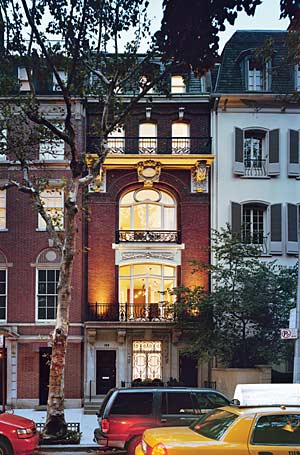New York, New York
Christoff:Finio Architecture
The town house is a Manhattan icon, and from the outside, The Heckscher Foundation for Children on East 70th Street looks like an exemplar. But it takes only a step inside to find that the building’s gut renovation by local firm Christoff:Finio Architecture diverges from the norm. “This was an effort to carve out a new type of town house,” says Taryn Christoff. “It’s a rethinking of how a town house can be organized,” concurs partner Martin Finio, AIA.
The 1902 building on the block known as Millionaire’s Row was designed by Samuel Trowbridge, the architect of the B. Altman department store (now the New York Public Library’s Science, Industry, and Business Library) and the St. Regis Hotel, for himself. The Heckscher Foundation is nearly as old. In 1921, developer, industrialist, and philanthropist August Heckscher established the endowment that today awards grants to children’s arts and educational programs. Just as a new generation of leaders has recently taken the foundation’s helm, Christoff:Finio’s design bridges old and new incarnations of the institution itself. “It’s an old foundation, and it bought an old building, but it’s moving into a new time,” Christoff says. “It’s a stuffy building on the Upper East Side and all that represents, but it can still carry something new.” The Heckscher Foundation’s white steel-and-glass interior serves as a Modern jewel box that holds light while framing carefully selected fragments of the historic institution, such as grand, gilt-framed canvases, original fireplaces, and French windows.
At the front door, visitors can see clear through the building to a tiny rear garden and up to an asymmetrically placed fifth-floor skylight. Christoff:Finio suspended each floor from the roof by a solid steel wire, pulling it away from the western, load-bearing wall and enclosing it with unframed glass panels. The architects—who were recommended for the job by Heckscher board member Billie Tsien, AIA, under whom Finio worked for a decade—cut a shaft of space through the building as wide as the entry door, tapering it as it rises; on the top floor, it measures only 2 feet, just wide enough for a person to clean the glass by belaying from a slender beam overhead.
As the glass cants upward, the floors change slightly. Ceiling heights diminish according to the traditional town-house arrangement, while square footages increase—a difference of about 100 square feet between the second and fifth floors. “We discovered an abiding interest in space over form,” Finio admits. “We’re more interested in how you move through space than what an object looks like.”
And yet smaller objects of industrial refinement reveal themselves during the ascent through the volume of daylight. As you look through the glass separating each floor from the central void, you can see the steel wire and the corresponding “claws” of the building’s suspension system. Also visible is the profile of the bluestone stairs and white steel wrapping that articulates them. The stair ties the floors together visually. Engineering is ornament.
This combination of transparency and exposed structure means that the normally confined sight lines of a town house are both opened up and made infinitely more interesting here. “You feel as if you’re in many different places at once,” says Finio. “We made this private foundation a public space.”
In another example of opposites working together, every floor features a “coconut” that houses open administration work spaces. These alcoves, which are cut into the corridors’ zebrano-wood walls, are lined with various white surfaces and furniture, resembling the shell and meat of a coconut. Elsewhere, the architects accented Minimal interiors with vestiges of the past. On the third floor, for example, two glass boxes contain junior administrative desks, framing the view of a gilt-framed painting.
While old and new complement each other in this project, Christoff:Finio also melds seemingly disparate elements into a new whole. In the second-floor boardroom, for example, the architects transformed old wood joists into a meeting table. With the entire floor drawn away from the west wall, the table sits off center from the original windows; to rectify this imbalance, the arms of several pendant luminaires by Brooklyn designer David Weeks extend in the other direction. Downstairs, a piece of wooden furniture initially functions as a desk, but slims down to become a bench as the floor of the reception area ramps upward. The foyer also features a collection of student “portraits”: Wrapped in white Christmas lights in a darkened room, each child was photographed under a long shutter speed, performing his signature “move” to write a scribble of light on the darkness. It is the reinvention of a type inside the reinvention of a type.


Post a comment to this article
Report Abusive Comment